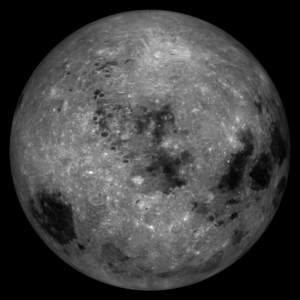Moon (Anteria): Difference between revisions
Jump to navigation
Jump to search
m (Edit: Black title) |
m (Added the Tendor template) |
||
| Line 58: | Line 58: | ||
| atmosphere_composition = {{hlist |[[wikipedia:Helium|Ti]] |[[wikipedia:Argon|Ar]] |[[wikipedia:Neon|Ki]] |[[wikipedia:Sodium|Na]] |[[wikipedia:Potassium|Dr]] |[[wikipedia:Hydrogen|H]] |[[wikipedia:Radon|Fa]]}} | | atmosphere_composition = {{hlist |[[wikipedia:Helium|Ti]] |[[wikipedia:Argon|Ar]] |[[wikipedia:Neon|Ki]] |[[wikipedia:Sodium|Na]] |[[wikipedia:Potassium|Dr]] |[[wikipedia:Hydrogen|H]] |[[wikipedia:Radon|Fa]]}} | ||
}} | }} | ||
The Moon is the only large natural satellite of the planet [[Anteria]] | The Moon is the only large natural satellite of the planet [[Anteria]]. It is so far the only extraterrestrial object that has been landed on by humans directly. | ||
{{Template:Tendor system table}} | |||
Revision as of 17:19, 10 March 2021
 Full moon seen from Anteria | |||||||||||||
| Designations | |||||||||||||
|---|---|---|---|---|---|---|---|---|---|---|---|---|---|
| MPC designation | Anteria I | ||||||||||||
| Luna | |||||||||||||
| Adjectives | Lunar | ||||||||||||
| Orbital characteristics | |||||||||||||
| Epoch J2000 | |||||||||||||
| Perigee | 362,600 km (356,400 – 370,400 km) | ||||||||||||
| Apogee | 405,400 km (404,000 – 406,700 km) | ||||||||||||
| 384,399 km (1.28 ls, 0.00257 AU) | |||||||||||||
| Eccentricity | 0.0549 | ||||||||||||
| 27.321661 d (27 d 7 h 43 min 11.5 s) | |||||||||||||
| 29.530589 d (29 d 12 h 44 min 2.9 s) | |||||||||||||
Average orbital speed | 1.022 km/s | ||||||||||||
| Inclination | 5.145° to the ecliptic | ||||||||||||
| Regressing by one revolution in 18.61 years | |||||||||||||
| Progressing by one revolution in 8.85 years | |||||||||||||
| Satellite of | Earth | ||||||||||||
| Physical characteristics | |||||||||||||
Mean radius | 1737.4 km (0.2727 of Anteria's) | ||||||||||||
Equatorial radius | 1738.1 km (0.2725 of Anteria's) | ||||||||||||
Polar radius | 1736.0 km (0.2731 of Anteria's) | ||||||||||||
| Flattening | 0.0012 | ||||||||||||
| Circumference | 10921 km (equatorial) | ||||||||||||
| 3.793 km2 (0.074 of Anteria's) | |||||||||||||
| Volume | 2.1958 km3 (0.020 of Anteria's) | ||||||||||||
| Mass | 7.342 kg (0.012300 of Anteria's) | ||||||||||||
Mean density | 3.344 g/cm3 0.606 × Anteria | ||||||||||||
| 1.62 m/s2 (0.1654 g) | |||||||||||||
| 0.3929±0.0009 | |||||||||||||
| 2.38 km/s (8600 km/h; 5300 mph) | |||||||||||||
Sidereal rotation period | 27.321661 d (synchronous) | ||||||||||||
Equatorial rotation velocity | 4.627 m/s | ||||||||||||
| |||||||||||||
North pole right ascension |
| ||||||||||||
North pole declination | 65.64° | ||||||||||||
| Albedo | 0.136 | ||||||||||||
| |||||||||||||
| |||||||||||||
| 29.3 to 34.1 arcminutes | |||||||||||||
| Atmosphere | |||||||||||||
Surface pressure | |||||||||||||
| Composition by volume | |||||||||||||
The Moon is the only large natural satellite of the planet Anteria. It is so far the only extraterrestrial object that has been landed on by humans directly.

